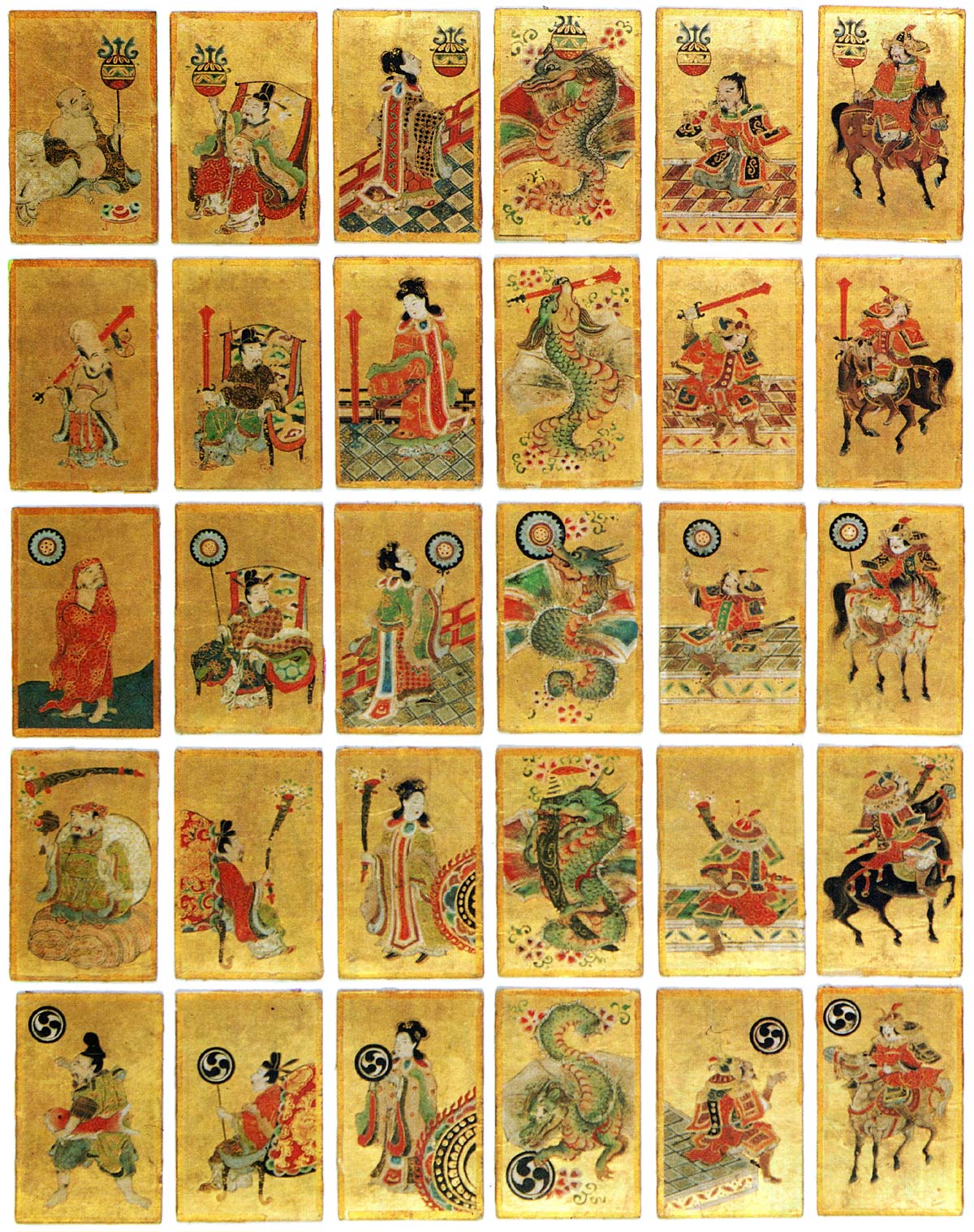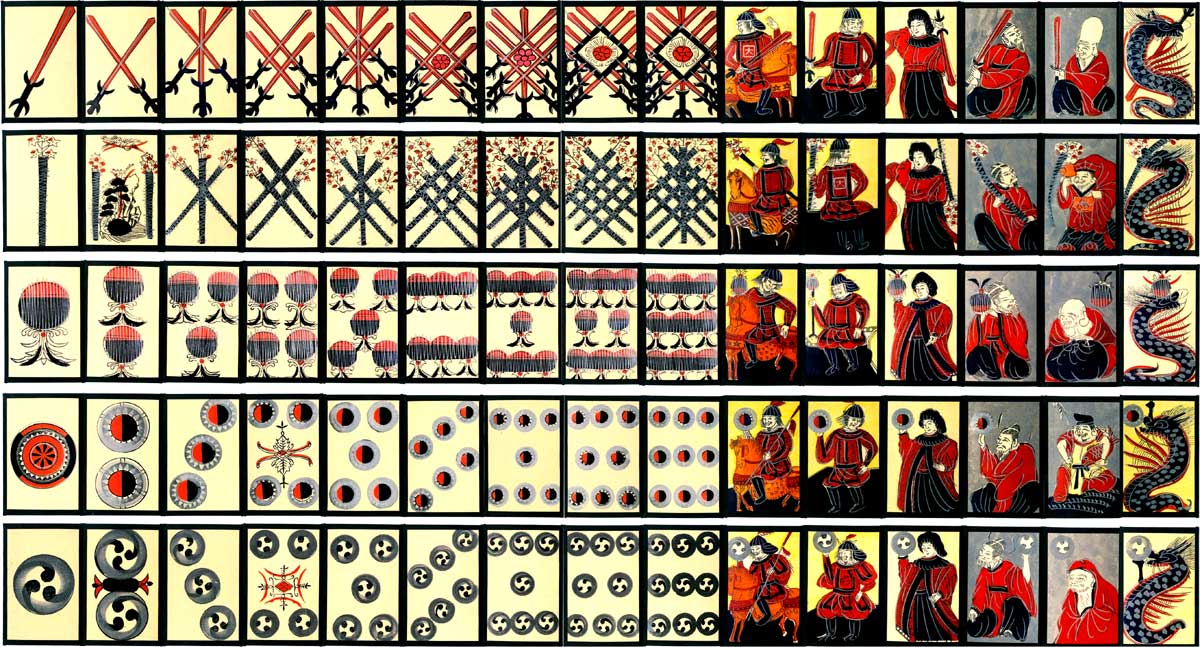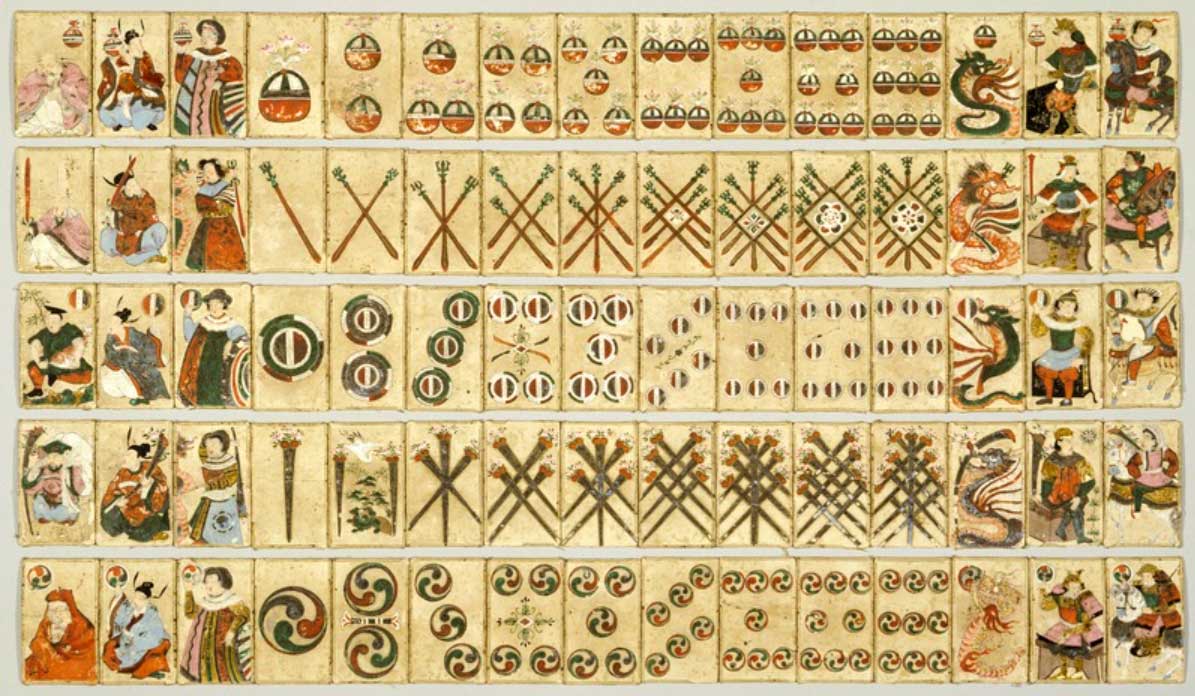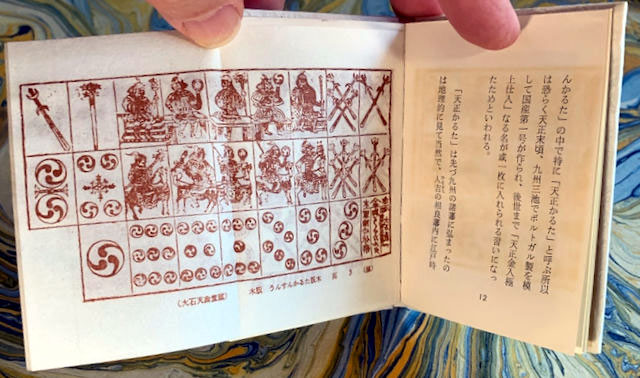Unsun Karuta
Unsun Karuta うんすんかるた Japan c.1780.
うんすんかるた
These cards have retained much of their original appearance to Portuguese “dragon cards” but over time local influences and traditions have localised the designs. The first copies of western-style playing cards were made in Japan during the Tenshou Era (1573~1591) and became known as Tenshou Karuta. Subsequently, in the Edo period, they were developed further into Unsun Karuta. While Tenshou Karuta had 48 cards, Unsun Karuta has 75 cards and more complicated rules. As Unsun Karuta gained popularity, the gambling potential of the game caused it to be banned. Believed to have entirely disappeared, it survived in the Hitoyoshi region in Kumamoto.

Above: 30 cards from an 18th century hand-painted Unsun Karuta pack. The complete pack has 5 suits of 15 cards: Cups, Swords, Coins, Batons and Tomoe or Drums. Each suit has six court cards: Un (a god of good luck or, in one instance, Daruma, a Zen Buddhist); Sum (an enthroned Chinese official); Sota (a maid); Robai (a dragon which has been transferred from the Portuguese aces to the Japanese court); Kiri or Koshi (King or other enthroned person), and Uma (Cavalier or simply a horse). There are also numerals 9-1, the aces being represented simply by a single suit symbol without a dragon.
Whilst the “dragon cards” have been preserved in the deck along with an extended court, there are also aces with single suit symbols. Thus numerals 1-9, plus five court cards + dragon card in each of FIVE suits = 75 cards.

A typical way of playing involves 8 players divided into 2 groups of 4 people who alternately perform trick-taking.
Further References (with thanks to Alex Concutelli for extra research)
Hitoyoshi, Kumamoto's Hidden Portuguese Card Game: Unsun Karuta►
Mann, Sylvia: All Cards on the Table, Jonas Verlag/Deutsches Spielkarten-Museum, Leinfelden-Echterdingen, 1990
Japan Playing Card Museum: Unsun Karuta►

Above: Unsun Karuta, 17th century. The Portuguese were banned from visiting Japan in 1639, but it is believed that these cards were made around that time. Kyushu National Museum, Collection number A20►
See Wikipedia for more information see here and Unsun Karuta and the Portuguese influence►
A description of the rules of Unsun Karuta can be found here and here - usually the browser suggests to translate the page.
Link to Nippon Kichi: Unsun-karuta card game►
Link to Hitoyoshi tourist region, the only place where Unsun Karuta was not banned
Keizaburo Yamaguchi (1928-2012): Unsun Karuta: An Outline History of Unsun-Karuta: (Old Japanese Playing Card of Portuguese Origin), published by Tekisui Art Museum at the Yamaguchi Culture Hall, 1967. Keizaburo Yamaguchi was a Japanese art historian; here he relates how playing cards were imported into Japan in the seventeenth-century, and then explains how and where these cards were adapted by the Japanese and how a popular social movement grew up around them.

Above: image from Keizaburo Yamaguchi book.

By Simon Wintle
Member since February 01, 1996
I am the founder of The World of Playing Cards (est. 1996), a website dedicated to the history, artistry and cultural significance of playing cards and tarot. Over the years I have researched various areas of the subject, acquired and traded collections and contributed as a committee member of the IPCS and graphics editor of The Playing-Card journal. Having lived in Chile, England, Wales, and now Spain, these experiences have shaped my work and passion for playing cards. Amongst my achievements is producing a limited-edition replica of a 17th-century English pack using woodblocks and stencils—a labour of love. Today, the World of Playing Cards is a global collaborative project, with my son Adam serving as the technical driving force behind its development. His innovative efforts have helped shape the site into the thriving hub it is today. You are warmly invited to become a contributor and share your enthusiasm.
Related Articles

Eki karuta
Japanese fortune-telling cards based on I Ching, with bold, modern designs.

Victorian grocer’s scale plate
Large flat plate decorated with highly coloured English cards and royal arms.

Rouen Pattern - Portrait Rouennais
An attractive XV century French-suited design from Rouen became the standard English & Anglo-America...

Iroha Karuta for Hino City
Special version of Iroha Karuta, a traditional Japanese matching game, made for Hino City, Tokyo.

Iroha Karuta
Traditional Japanese matching game played mainly by children.

Heathen Divinities
Handmade playing cards from the British Museum depicting classical Greek and Roman gods and goddesse...

Hand-drawn set of 52 playing cards
An imaginatively hand-drawn set of 52 playing cards by an amateur artist, 18th century.

Playing cards with prints by Sumio Kawakami
Woodblock print designs created by Sumio Kawakami in 1938-9, each card having a different illustrati...

Ganjifa - Playing Cards from India
Indian playing cards, known as Ganjifa, feature intricate designs with twelve suits and are traditio...

Hanuman and the Five Riders
A selection cards showing characters from the 1975 Thai-Japanese film.

The Henry Hart Puzzle
Explore the intricate history and unique design variations of Henry Hart's playing cards, tracing th...

Sevilla 1647 reproduction
Facsimile of Spanish-suited pack produced in Sevilla, Spain, 1647.

Why our playing-cards look the way they do
Analysis of early playing card designs: origins, suit differences, standardization, technological ad...

Introduction to Collecting Themes
Playing cards can be broadly categorised into standard and non-standard designs, with collectors app...

Le Monde Primitif Tarot
Facsimile edition produced by Morena Poltronieri & Ernesto Fazioli of Museo Internazionale dei Taroc...

Guanlangaoshou / Slam Dunk playing cards
Basketball-themed manga animated playing cards from Japan.
Most Popular
Our top articles from the past 28 days

